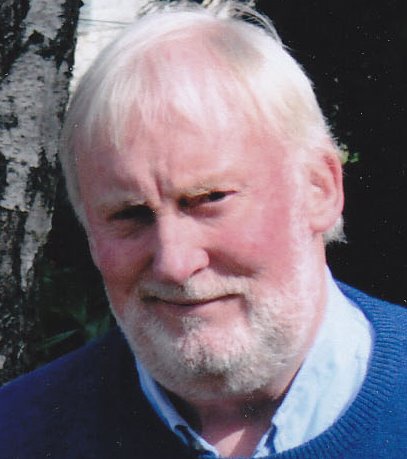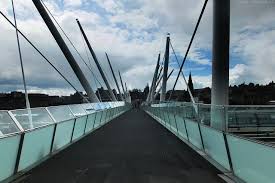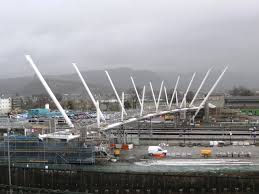 When Michael Portillo embarks on one of his Great British Railway journeys, the sun usually shines as brightly as his jacket as he steps effortlessly on to a freshly presented train, with several vacant seats available to himself, his Bradshaw and presumably a television crew as well. This was not quite my experience at the end of last week when I set off on my modest rail journey from Stirling to Glasgow Queen Street.
When Michael Portillo embarks on one of his Great British Railway journeys, the sun usually shines as brightly as his jacket as he steps effortlessly on to a freshly presented train, with several vacant seats available to himself, his Bradshaw and presumably a television crew as well. This was not quite my experience at the end of last week when I set off on my modest rail journey from Stirling to Glasgow Queen Street.
For a start, there was a leaden grey sky, though only a light sprinkling of drizzle, as I set out from my budget hotel for Stirling station approximately a quarter of a mile away. I had with me a leather rucksack and a walking pole grasped in my right hand. I had the pedometer clipped in place (see previous post). Also, I was not wearing a brightly coloured jacket, though my spirits were bright enough. I was aiming for the 9.15 am service from Stirling, which promised a speedy, non-stop journey of 30 minutes to Glasgow, in plenty of time for a meeting at Glasgow Caledonian University, a mere 826 paces from the station (see previous post, again).
 In order to reach Stirling station, I had to walk across the new Forthside Bridge. This is a dramatic structure in steel and glass which links the Forthside area, where I had spent the night, with the car park adjacent to the station. A plaque at the southern end tells passers-by that it was opened in 2009. On the website of the architects, it is described as follows:
In order to reach Stirling station, I had to walk across the new Forthside Bridge. This is a dramatic structure in steel and glass which links the Forthside area, where I had spent the night, with the car park adjacent to the station. A plaque at the southern end tells passers-by that it was opened in 2009. On the website of the architects, it is described as follows:
This bridge greatly improves pedestrian connections between Stirling’s town centre and railway station. The bridge is aligned to better suit pedestrian desire lines and promote physical and visual connectivity with the town to establish an enhanced sense of place. It also offers a series of spectacular views – to the Wallace Monument, Cambuskenneth Abbey and to nearby Stirling Castle.
The station has attractive triangulated lightweight trusses and fluid panes of translucent glazing, and these are reflected in the design of the bridge. This is a contemporary interpretation of the traditional ‘fink truss’ structure, which is inverted here to support the deck from above. The trusses are arranged asymmetrically and change size incrementally along the length of the bridge to create an organic twisting form. The resulting structure is both dramatic and visually ‘light’, the steel masts and cables contrasting with laminated glass infills at parapet level. At night these appear to glow, creating a shifting ‘glass ribbon’ of colour along the length of the bridge.
 I am not sure what “pedestrian desire lines” are, but on paper, at least, some thought has been put into the bridge design for those of us who are – how can I put it? – less than agile. There is a lift at each end to make life easier, according to the designers, for those who are “elderly or have mobility problems” – or both, I suppose, in my case. When I reached the southern end, I discovered that the whole lift area had been blocked off with sheets of ugly dark plywood. There was no explanation as to why this was the case, but it meant that either I had to climb the four flights of stairs on to the bridge deck or make a lengthy detour to the station alongside busy roads. I later discovered that both lifts were a target for chronic vandalism and had been out of action for years – that merits a plaque as well, in my view. Anyway, reckoning that the steps were probably a better bet than the traffic fumes, I began the ascent, sticking to the right side of the stairway and holding on to the bright steel hand rail, now shiny and slippery with rain.
I am not sure what “pedestrian desire lines” are, but on paper, at least, some thought has been put into the bridge design for those of us who are – how can I put it? – less than agile. There is a lift at each end to make life easier, according to the designers, for those who are “elderly or have mobility problems” – or both, I suppose, in my case. When I reached the southern end, I discovered that the whole lift area had been blocked off with sheets of ugly dark plywood. There was no explanation as to why this was the case, but it meant that either I had to climb the four flights of stairs on to the bridge deck or make a lengthy detour to the station alongside busy roads. I later discovered that both lifts were a target for chronic vandalism and had been out of action for years – that merits a plaque as well, in my view. Anyway, reckoning that the steps were probably a better bet than the traffic fumes, I began the ascent, sticking to the right side of the stairway and holding on to the bright steel hand rail, now shiny and slippery with rain.
Once I had attained the deck, I walked over the bridge high above the railway until I reached the four flights down at the other end. As many people affected by mobility problems following stroke will tell you, ascents are usually okay, it is the descents that pose the fiercest challenge. My descent was hindered somewhat by the fact that someone had vomited copiously all the way down the four flights of descending steps – on the right hand side, of course (my “good” side) – so my challenge was made all the greater by keeping my feet clear of the resulting mess and ensuring my walking pole remained dangling clear of it from my wrist whilst at the same time holding on to the slippery chrome hand rail. I am confident that the inelegant vision I presented during this descent was not one that the bridge architects would wish to appear as a short video clip on their web page. Let me put it this way – I was certainly untroubled by thoughts of pedestrian desire lines, though I did wonder if the architects had in mind the same “ribbon of colour” as the one I was carefully avoiding. On my way down, a young man ascending the steps kindly asked if I was okay. “Just dodging the vomit,” I replied cheerily, while inwardly howling with frustration.
Platform 3 was crowded, and I was out of breath, when the 9.15 drew in. It was already a packed train, with people standing in every one of the three carriages. Weary from my encounter with the Forthside Bridge, I could not face the thought of standing for thirty minutes, and balancing myself against the movement of the train all the way to Glasgow.
Some distance away, at platform 7 an emptier looking train for Glasgow was waiting. This was a local stopping service, which promised a slower but potentially more comfortable trip. As I neared the train, a small grim-faced woman barged me aside. She was laden with plastic bags, which seemed to contain more than her fair share of toilet rolls. She pushed into the rearmost carriage and I followed her a few moments later.
I took my seat across the corridor from Ms Toilet Rolls, who had spread her bags over all adjoining seats. I then allowed my senses to take in the full glory of the train’s “enhanced sense of place”, as a Forthside Bridge architect might put it – the pungent aroma of fast food, the dozens of chattering mobile phone calls, the assorted pings of electronic gadgetry and the screams of merry infants, excited to fever pitch by the jolly black Friday atmosphere. None of this would have happened to me, I thought, if I had had a straightforward career as a cabinet minister and television presenter. Perhaps if I had worn a brighter jacket….
